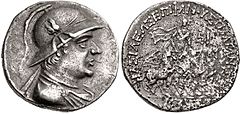

Plato Epiphanes (Ancient Greek: Πλάτων ὁ Ἐπιφανής, Plátōn ho Epiphanḗs, "Plato the God-Manifest") was a Greco-Bactrian king who reigned for a short time in southern Bactria or the Paropamisade during the mid 2nd century BCE. The style of Plato's coins suggests that he was a relative — most likely a brother since Plato is a middle-aged man on his coins — of Eucratides the Great, whose rise to power is dated to around 170–165 BCE.
Some of Plato's coins have inscriptions which may possibly be interpreted as dates using the Indo-Greek era which started around 186 BCE. In that case Plato ruled around 140 BCE. This matches the dating given by numismatician Bopearachchi, who places Plato between 145–140 BCE, since his coins are not found in the ruins of Ai Khanoum, a Bactrian city which was destroyed during the reign of Eucratides.
Coinage
-
 Silver coin of Plato Epiphanes wearing a crested Bactrian helmet adorned with bull's horn and ear.
Silver coin of Plato Epiphanes wearing a crested Bactrian helmet adorned with bull's horn and ear.
-
 Another coin of Plato Epiphanes, bare headed and wearing a diadem.
Another coin of Plato Epiphanes, bare headed and wearing a diadem.
See also
- Greco-Bactrian Kingdom
- Seleucid Empire
- Greco-Buddhism
- Indo-Scythians
- Indo-Parthian Kingdom
- Kushan Empire
References
- "The Shape of Ancient Thought. Comparative studies in Greek and Indian Philosophies" by Thomas McEvilley (Allworth Press and the School of Visual Arts, 2002) ISBN 1-58115-203-5
- "Buddhism in Central Asia" by B. N. Puri (Motilal Banarsidass Pub, January 1, 2000) ISBN 81-208-0372-8
| Preceded by: Eucratides I? |
Greco-Bactrian Ruler (Bactria or its tributaries) |
Succeeded by: Eucratides II? |
| Hellenistic rulers | |
|---|---|
| Argeads | |
| Antipatrids | |
| Antigonids | |
| Ptolemies |
|
| Monarchs of Cyrene | |
| Seleucids |
|
| Lysimachids | |
| Attalids | |
| Greco-Bactrians | |
| Indo-Greeks |
|
| Monarchs of Bithynia | |
| Monarchs of Pontus | |
| Monarchs of Commagene | |
| Monarchs of Cappadocia | |
| Monarchs of the Cimmerian Bosporus |
|
| Monarchs of Epirus | |
| Hellenistic rulers were preceded by Hellenistic satraps in most of their territories. | |